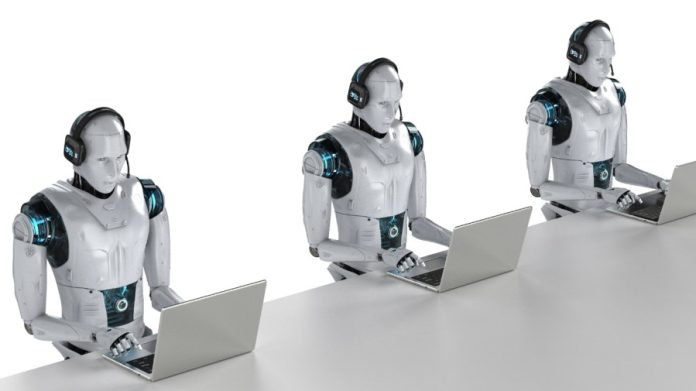
In the space of just a few quarters, AI systems moved from novel office tricks to everyday tools that quietly erase the first rungs of many careers. As a result, the entry-level American dream is getting squeezed out by “code and compute.”
The displacement starts where work is most codified, and it is happening fast enough that we can measure it in real time.
In AI-exposed fields such as software development and customer service, early-career employment is sliding. But older cohorts continue to hold their ground, according to a recent study by three researchers at Stanford. That means the Trump administration’s new “AI Action Plan,” framed around removing barriers and investing in AI infrastructure — such as taking a stake in Intel — risks intensifying the squeeze if it is not paired with robust worker policies.
In short, we need to match AI ambition with large-scale job retraining and a basic income floor, or risk watching opportunity narrow for the next generation.
The clearest pattern in the study is both simple and sobering. In the most AI-exposed occupations, workers aged 22 to 25 saw employment fall by 13 percent relative to peers in less-exposed roles, even after accounting for firm-level shocks. Wages barely budged, which means adjustment is happening through headcount rather than lower paychecks.
The timing matters. Since late 2022, when generative AI adoption exploded across workplaces, employment for 22- to 25-year-olds in the most exposed jobs fell by 6 percent, while the number of workers ages 35 to 49 in those same occupations grew by “6 to 9 percent.” That split lines up with a basic intuition about how AI affects the workplace. Entry-level roles lean on codified knowledge that models can replicate cheaply, whereas experienced workers contribute tacit judgment, domain context and organizational savvy, which AI cannot yet replace at scale.
The mechanism shows up when you sort jobs by how AI is used. Where AI primarily automates tasks, entry-level employment contracts. Where AI genuinely augments human work, employment for young workers stabilizes or grows. Tasks that can be pushed into a prompt are collapsing into tools. Tasks that require teams, customers and context are not.
The Trump administration has reoriented federal AI policy around acceleration. In January 2025, the White House issued “Removing Barriers to American Leadership in Artificial Intelligence,” an executive order that revoked the prior administration’s AI guardrail order and directed officials to produce an “Artificial Intelligence Action Plan.” The order’s thrust is to sustain and enhance American AI dominance, revise agency guidance to align with that goal, and clear away policies seen as obstacles.
Acceleration has value. It also has a labor cost, if you ignore the evidence. This is not an argument to slow AI, but to stop treating workforce policy as an optional add-on. An action plan that maximizes deployment while leaving displaced workers to absorb the shock will worsen the early-career crunch. That is a structural signal, not a temporary blip.
A durable AI strategy marries acceleration with transition support. Start with retraining that is built for the way modern workers actually learn. Fund employer-validated, short-cycle programs that move people into augmentative roles where employment is rising. Focus on skills that compound with AI instead of competing directly with it. Make training portable and time-bound. Replace fragmented grants with individual learning accounts that workers can draw on when tools change and tasks go away.
In addition, add wage-linked supports that keep people attached to the labor market while they retool. Temporary wage insurance cushions earnings losses when workers step down to reenter a new field. Subsidized apprenticeships in AI-complementary jobs provide supervised experience that no model can fake.
These are not theoretical ideas. They are pragmatic ways to turn early-career workers from the first victims of automation into the first beneficiaries of augmentation.
Finally, test a basic income floor where the data say risk is highest. The paper shows the sharpest dislocations among 22- to 25-year-olds in automation-exposed occupations. That is the right population for time-limited basic income pilots funded at the federal level and administered locally. Combine the stipend with mandatory participation in training or job placement, and you get the stability to retrain plus the nudge to stay engaged with work.
The point is not to replace jobs but to buy the time required for new tasks and new firms to materialize — a dynamic that past technology waves have delivered only after painful adjustments.
America needs two hands on the wheel. On one side, the administration should pursue AI leadership through research, standards and deployment. On the other, it must act on what the labor data already show. Early-career workers in AI-exposed jobs are losing footholds, and those losses are strongest where AI automates rather than augments.
Put these threads together and the policy path is clear. Pair the action plan with aggressive, employer-aligned retraining, wage-linked transition supports, and a basic income floor targeted to the workers absorbing the shock. That combination preserves U.S. dynamism and honors a core promise of economic growth, which is that progress should expand the circle of opportunity.
The alternative is a faster AI future with fewer places for new workers to stand.
Gleb Tsipursky, Ph.D., serves as the CEO of the hybrid work consultancy Disaster Avoidance Experts and authored the best-seller “Returning to the Office and Leading Hybrid and Remote Teams.”

